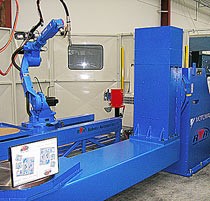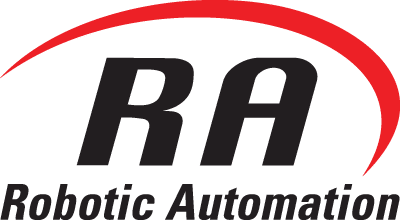Robotic Welding – Railway Bogies
CLIENT : Australian Railway Bogie Manufacturer
PROBLEM : Our client produces large railway bogies that carry bulk raw materials between cities across the country. The undercarriages are made up of large mild steel structures and these were being MIG-welded together by skilled tradesman.
The work is repetitive and intensive – with long weld seams that must be traced consistently and accurately across parts (up to four metres long!) to achieve safe, strong and reliable welds. This prolonged concentration and physical strain wears heavily on the tradesmen and requires significant break-times throughout the process to ensure staff can maintain the quality of their work and also, importantly, their attention to safety with live welding equipment. Some components take several hours of welding (each!) to complete. Strain injuries are understandably common.
Our client employed three skilled welding staff but found it increasingly difficult to maintain the positions. Staff turnover was high – given the nature of the work, and the continuing skills shortage. This meant delays in re-staffing which in turn threatened production and created a “bottle-neck” that impacted all subsequent processes in the manufacturing cycle.

SOLUTION : Robotic Automation P/L’s engineering team consulted closely with the client to develop an integrated robotic welding solution with a large, yet fully synchronised 2-axis work-piece positioner and 4-metre robot traverse-track. Together, these total 3 external axes of movement which orientate the part and the robot’s proximity along the part as it performs each weld.
Additionally, the robot’s 6-axis body allows it to orient the torch at the optimum angle at all times. All this is synchronised by the powerful MOTOMAN NX-100 controller which can even support a further 27 axes of movement (or 3 other synchronised robots) if required. Importantly, the positioning system, robot and the controller’s memory is flexible enough to handle a series of varying carriage parts to be welded – bearing the brunt of the most painstaking work.
Advanced robotic functions specific to the welding challenge allow the system to respond to variance in the shape and surface of each work-part.

- Touch sensing allows the robot to physically confirm the position of the weld seam before commencing – optimising the quality at the start of the weld.
- COMARC tracking allows the robot to detect and respond in real time during the weld to slight defects and variances in the surface profile of each work-part.
- The OTC DP500 digital welder uses Synchro Short-Pulse – a shorter, rigid arc to allow the robot to weld at higher speed, with a more consistent droplet transfer, minimal spatter and better bead profile.
- A pneumatic torch-cleaning station allows the robot to regularly spray-clean its torch head and gas nozzles to keep them free of any spatter and flowing freely. The station also trims the welding wire precisely to perfect the next weld-start.
EQUIPMENT :
- MOTOMAN HP20-6 (extended reach version of HP-20 robot)
- MOTOMAN COMARC arc-tracking and touch-sensing options
- OTC DP500 Digital inverter pulse welder
- MOTOMAN MT1 1000 servo-powered 2-axis Positioner
- Servo-powered Traverse Track with 4 metres travel
- Safety Guarding System
- Torch Cleaning Station with pneumatic spatter-cleaner and wire-cutter
BENEFITS :
- Longer, continuous welds
- Higher quality welds of greater strength
- Improved consistency in the welds
- Improved weld appearance
- Improved staff safety
- Improved productivity
- Reduced costs and lost time to weld error
- Elimination of costs in injury claims & lost production time
- Elimination of lost production time to staff breaks
- Reduced labour costs (x3) and associated management / admin costs
